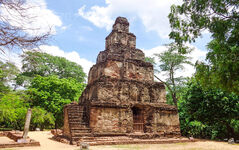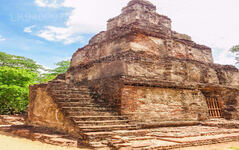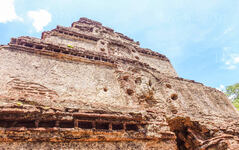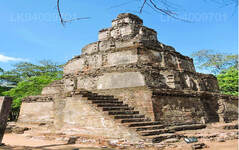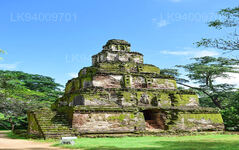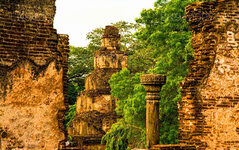
Polonnaruwa City
Polonnaruwa, a UNESCO World Heritage Site in Sri Lanka, was the country's medieval capital (11th-13th century). Renowned for its well-preserved ruins, including the iconic Gal Vihara statues, it showcases impressive architecture, reflecting the grandeur of the ancient Sinhalese civilization.
Sathmahal Prasada
Sathmahal Prasada in Sri Lanka: The Stepped Pyramid of Polonnaruwa
Sathmahal Prasada in Sri Lanka is a seven storied stepped pyramid located in an elevated area amongst the ancient city Polonnaruwa. The structure has entrances on all four sides and an additional staircase to reach the upper levels. It is believed to be built during the Polonnaruwa era, somewhere between the 11th and 13th century AD. However, no record exists of this pyramid, its builder or purpose.
The Seven Storied Palace is believed to be a stupa by some, due to its proximity to notable Buddhist ruins such as stupas, monasteries and etc. However the architecture is completely different and does not resemble any other ancient architecture in Sri Lanka. It is the only stepped pyramid in Sri Lanka and one of only four other ancient buildings with square bases, the others all being damaged stupas or monastic ruins in Anuradhapura. It is interesting to note that none of the other three buildings show signs of having been pyramids and all seem to have been squat in structure.
Sathmahal Prasada in Sri Lanka: Resemblance to Architectures beyond the Seas
Though it does not have comparative architecture in Sri Lanka itself, Sathmahal Prasada has similarities to the architecture of some cultures beyond the oceans.
• Stepped Pyramids are structures that use flat platforms or ‘steps’ in a receding order from ground up, to form a shape similar to a geometric pyramid. They are usually large and are built using several layers of stone.
• There are stepped pyramids found throughout history in many cultures and locations around the world.
• Interestingly enough, there were no firmly established connections between the different cultures.
• Sathmahal Prasada is most similar in structure (except for the staircase) to the Koh Ker temple and Baksei Chamkrong temple in Siem Reap, Cambodia (both are Shiva temples built around the 10th century AD), and on a smaller scale similar to the Mayan Temple of the Masks in Tikal, Gautemala and some other Mayan temples.
About Polonnaruwa District
Polonnaruwa is the 2nd largest city in north central province in Sri Lanka. The ancient city of Polonnaruwa has been declared a World Heritage site by UNESCO Polonnaruwa has a great history of conquest and struggle behind it and rightfully forms the third element in the Cultural Triangle. Located about 140 kms north east from Kandy,Polonnaruwa offers hours of endless pleasure for history and culture lovers, as there are numerous sights of significance.
Much of the physical ruins standing today are credited to King Parakrama Bahu I who spent many royal resources on town planning, including parks, edifices, irrigation systems and so on. The period of his rule is considered a golden age where the kingdom thrived and prospered under a visionary ruler. The Parakrama Samudra is a mammoth tank and named after its patron. The popular kings Royal Palace, the Audience Hall encircled by beautifully carved stone elephants and the Bathing Pool reflect the superior engineering capabilities of the time.
About North Central Province
North Central Province which is the largest province in the country covered 16% of total country's land area. North Central Province consist two districts called Polonnaruwa and Anuradhapure. Anuradhapura is the largest district in Sri Lanka. Its area is 7,128 km².
North Central Province has numerous potentials for Investors to start their Businesses, especially Agriculture, agro based industries and Livestock sectors. More than 65% of North Central Province's people depend on basic Agriculture and agro base industries. NCP also called "Wew Bendi Rajje" because there are more than 3,000 medium and large scale tanks situated in the province. Sri maha bodiya, Ruwanweli seya, Thuparama dageba, Abayagiri Monastry, Polonnaruwa Rankot wehera, Lankathilake are scared

